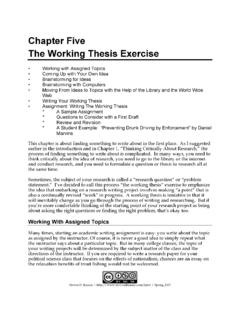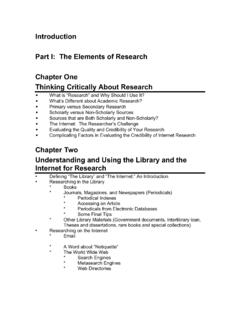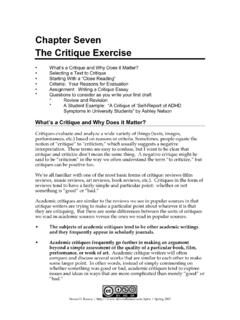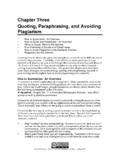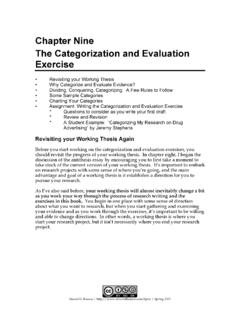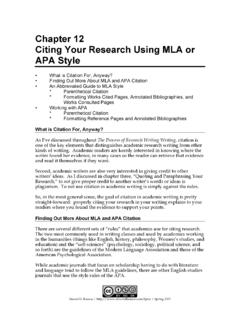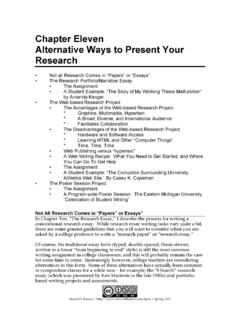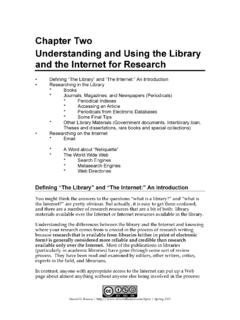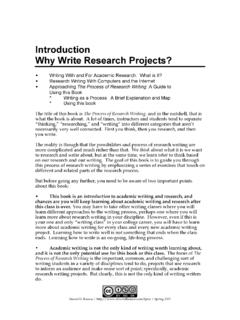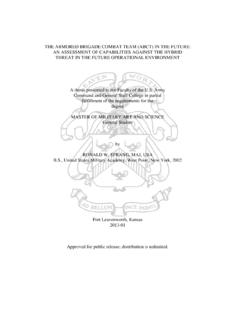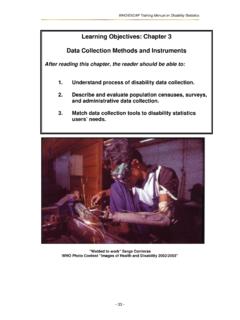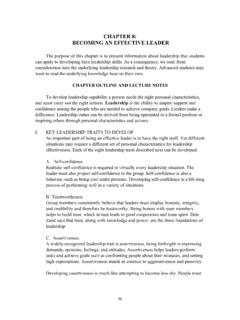Transcription of Chapter Four: How to Collaborate and Write With Others
1 Steven D. Krause | | Spring 2007 Chapter four : How to Collaborate and Write with Others Why Collaborate on Writing? Considering (and Balancing) the Two Extremes of Collaboration Peer Review as Collaboration * A sample recipe for how peer review can work * A few last things to remember about successful peer review Collaborative Writing on Larger Projects Three Ideas for Collaborative Projects * Research Idea Groups * Research Writing Partners * Collaborative Research Writing Projects Collaborating with Computers and the Internet Why Collaborate on Writing? In my teaching experience, students have mixed feelings about collaboration. Many of my students initially say they don t want to work with their classmates on their writing. When it comes to in-class peer review sessions or more involved collaborative project such as small group work, they believe there is nothing they can learn about their writing from their classmates; After all, they tell me, the teacher gives the grade.
2 However, most of my students tell me after the course ends that the times in which they collaborated with their classmates were occasions where they felt they learned a lot about writing. While they might enter into collaborative exercises and writing projects reluctantly, it s been my experience that most students end up finding them worthwhile. Collaborating in different ways on writing projects is a good idea for several reasons. First, composition and rhetoric teachers and scholars have known for a long time now that one of the best ways for students to improve their writing skills is to have them share their writing with other students. If you think about it for a moment, this is common sense. If you never show your writing to other readers, or if you limit your audience to simply the teacher, how will you as a writer learn about the effectiveness of your writing beyond a grade in a class?
3 Second, almost all real writing is the product of collaboration. Of course, you probably don t Collaborate on your diary or journal entries, letters to relatives, or emails to your friends. But almost all of the writing you read in academic or popular publications has involved different levels of collaboration, sometimes in surprising and hidden ways. For example, while I am indeed the author of The Process of Research Writing, this book has been a collaborative project in the sense The Process of Research Writing Chapter four , How to Collaborate and Write with Others , 2 Steven D. Krause | | Spring 2007 that I received a lot of advice and ideas from my wife, friends, students, colleagues, and editors. Considering (and Balancing) the Two Extremes of Collaboration Collaboration always implies people working together toward a goal, but I like to think of the way collaboration actually works as being somewhere between two extremes.
4 One extreme is what I call very immediate and intimate collaboration, where writers Collaborate extremely closely, literally sitting together in front of the computer keyboard or the pad of paper and going over each sentence of each paragraph together. The advantages of this very close collaboration include: An equal and immediate sense for everyone involved about how the project is going; Writing projects that are more seamless: that is, all of the different parts fit together clearly as one complete text; and A greater sense by individuals within a group of their roles, since all the group members are working together in the same time and place. The disadvantages of this type of collaboration include: Hard workers in the group might resent the group members who do not seem to contribute an equal part, or some members of the group might feel they are being silenced and manipulated by more forceful group members; It can be difficult to coordinate times and places to meet; and It is extremely time consuming, especially if the group is collaborating on creating a more detailed writing project.
5 The other extreme of collaboration is what I call very distant collaboration, where writers divide up the labor of a particular project into smaller tasks that can be then assigned to members of the group and put together later, assembly-line fashion. Some of the advantages of this type of collaboration include: It is easy to set up tasks so each group member has the opportunity to contribute equally without duplicating the work of Others ; The Process of Research Writing Chapter four , How to Collaborate and Write with Others , 3 Steven D. Krause | | Spring 2007 It can be done with few (if any) meetings where all of the group members need to be present; and Tasks can be accomplished quickly since all group members are simultaneously working on their parts of the project.
6 The disadvantages include: Because it is being done in parts, the completed project may seem disjointed and uneven; It can be difficult to manage this sort of collaboration since the individual parts of the project have to somehow be put together, usually by a group leader, someone who is named by the Others , or someone who takes on the role; and There can be resentment within the group, either from leaders who other members of the group feel are doing a poor job, or of those within the group perceived as not doing their share of the work. Where most collaborative projects end up on the collaboration spectrum depend on the nature of the collaborative task. For example, things like in-class peer review of each Others rough drafts, in-class reading and writing assignments, or shorter collaborative writing projects tend to end up closer to very immediate and intimate collaboration.
7 Things like collaborative research writing projects, research oriented web sites, or to other longer and more detailed writing projects tend to be closer to the very distant collaboration side of the spectrum. Clearly, one sort of collaboration isn t automatically better than another; it depends on your purposes. The best approach to any collaborative project is to be conscious of the strengths and weaknesses of both sides of the collaborative spectrum and strive to emphasize the strengths of the approach within which you are working. For example, one way to avoid some of the pitfalls of the very immediate and intimate types of collaboration is to make sure that each member of the group has a clear sense of their role in the writing project and is allowed to contribute. Conversely, the disadvantages of very distant types of collaboration might be avoided if members of the group strive to work on producing writing in a similar style and if there is frequent communication among group members.
8 Peer Review as Collaboration One of the most common types of collaboration done in writing classes comes in the form of in-class group work or as peer review sessions. Peer review has The Process of Research Writing Chapter four , How to Collaborate and Write with Others , 4 Steven D. Krause | | Spring 2007 become a common practice for contemporary composition and rhetoric classrooms. Basically, it is the process where small groups of students read, comment on, and make suggestions for other student s work. While successful peer review can be hard and takes practice, it really can work. But first, you have to be willing to accept two premises. Your fellow students have valid comments to make on your writing projects. Students often assume that the only person whose opinion really matters is the teacher because, after all, the teacher is the one who assigns the grade.
9 I understand the logic of the assumption that the teacher is always right, but I don t think it s true. The best writing projects are ones that strive to fulfill a purpose and reach an audience that is beyond a particular class and a particular teacher. But beyond that, your classmates represent an audience you should be trying to reach. You should listen to your classmate s suggestions because they are in same writing situation as you. After all, they too are trying to reach an audience that includes their fellow classmates, and they are also writing a project that will have to be read and evaluated by the teacher. All writing projects can be improved by revision. Sometimes we have an overly romantic view of writing and of writers who are able to create great works without ever having to make any real changes.
10 Rarely (if ever) has this been the case. Any writing project can be improved with revision. As straightforward as these premises might be, they can often be difficult to accept. But with practice, patience, and work with your classmates, seeing these premises as valid becomes easier. How peer review can work, step by step I offer the following advice on how to get started with peer review sessions as a recipe where ingredients and methods can be altered to fit the particulars of the class, the writing project, time limitations, and so forth. After all, you and your teacher probably have ideas on what will or won t work for peer review in your specific contexts. with the help of your teacher, break into groups of three to five students. Groups of five work well only if the writing project you are considering is short or if you have a lot of class time to go over each project.
